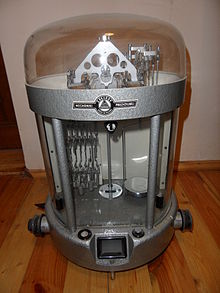



An analytical balance (or chemical balance) is a class of balance designed to measure small mass in the sub-milligram range. The measuring pan of an analytical balance (0.1 mg resolution or better) is inside a transparent enclosure with doors so that dust does not collect and so any air currents in the room do not affect the balance's operation. This enclosure is often called a draft shield. The use of a mechanically vented balance safety enclosure, which has uniquely designed acrylic airfoils, allows a smooth turbulence-free airflow that prevents balance fluctuation and the measure of mass down to 1 μg without fluctuations or loss of product.[citation needed] Also, the sample must be at room temperature to prevent natural convection from forming air currents inside the enclosure from causing an error in reading. Single pan mechanical substitution balance is a method of maintaining consistent response throughout the useful capacity of the balance. This is achieved by maintaining a constant load on the balance beam and thus the fulcrum, by subtracting mass on the same side of the beam as which the sample is added.[citation needed]
Electronic analytical scales measure the force needed to counter the mass being measured rather than using actual masses. As such they must have calibration adjustments made to compensate for gravitational differences from changing locations and altitudes.[1] They use an electromagnet to generate a force to counter the sample being measured and output the result by measuring the power (and resulting force) needed to achieve balance. Such a measurement device is called an electromagnetic force restoration sensor.[2]
There are three main types of analytical balances,[citation needed] electronic analytical balances, single-disk analytical balances, and electro-optical analytical balances. Electronic analytical balances are one of the commonly used instruments in chemical laboratories.
The original mechanical analytical balance was developed in the mid-18th century by Joseph Black, a Scottish chemist and physicist.[3]
- ^ A&D training material
- ^ "Sensors Mag". Archived from the original on 2014-01-06. Retrieved 2013-08-10.
- ^ "Equal Arm Analytical Balances". Archived from the original on 13 May 2017. Retrieved 8 March 2008.